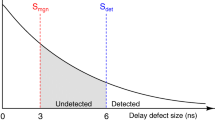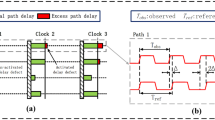Abstract
Timing prediction has become more and more difficult with shrinking technology nodes. Combining the pre-silicon delay model with post-silicon timing measurements has the potential to improve the accuracy of timing analysis. In this work, we address the problem of automatic test pattern generation for understanding circuit timing sensitivity to power supply noise (PSN) during post-silicon validation. Long paths are selected from a pseudo functional test set to span the power delivery network. To determine the sensitivity of timing to on-chip noise, the patterns are intelligently filled to achieve the desired PSN level. Our previous PSN control scheme is enhanced to consider both spatial and temporal information for better correlation with functional PSN. These patterns can be used to understand timing sensitivity in post-silicon validation by repeatedly applying the path delay test while sweeping the PSN experienced by the path from low to high.













Similar content being viewed by others
References
Bian K, Walker D M H, Khatri S, and Lahiri S (2013) Mixed structural-functional path delay test generation and compaction. Proc. IEEE Int Symp Defect Fault Tolerance VLSI Nanotechnol Syst pp. 7–12.
Cadence Design Systems, Voltage Storm Power Verification Datasheet, Retrieved from http://www.cadence.com/rl/Resources/datasheets/voltage_storm_ds.pdf, April 28, 2014.
Fan X, Reddy S, and Pomeranz I (2011) Max-fill: A method to generate high quality delay tests. Proc Int Symp Des Diagn Electr Circ Syst pp. 375–380
Fang L and Hsiao M S (2008) A fast approximation algorithm for MIN-ONE SAT. Proc Des Autom Test Eur pp. 1087–1090
Krstic A, Jiang YM, Cheng KT (2001) Pattern generation for delay testing and dynamic timing analysis considering power-supply noise effects. IEEE Trans CAD 20(3):416–425
Li X, Rutenbar R R, and Blanton R D (2009) Virtual probe: a statistically optimal framework for minimum-cost silicon characterization of nanoscale integrated circuits. Proc. IEEE/ACM International Conference on Computer-Aided Design pp. 433–440
Lin YC, Lu F, Cheng KT (2006) Pseudo functional testing. IEEE Trans CAD 25(8):1535–1546
Ma J, Tehranipoor M (2011) Layout-aware critical path delay test under maximum power supply noise effects. IEEE Trans CAD 30(12):1923–1934
Pei S, Li H, Li X (2012) A high-precision on-chip path delay measurement architecture. IEEE Trans VLSI 20(9):1565–1577
Remersaro S, Lin X, Zhang Z, Reddy SM, Pomeranz I and Rajski J (2006) Preferred fill: A scalable method to reduce capture power for scan based designs. Proc IEEE Int Test Conf pp. 1–10
Sde-Paz S and Salomon E (2008) Frequency and power correlation between at-speed scan and functional tests. Proc IEEE Int Test Conf pp. 1–9
Wang J, Qiu W, Fancler S, Walker D, Lu X, Yue Z.and Shi W (2005) Static compaction of delay tests considering power supply noise. Proc IEEE VLSI Test Symp pp. 235–240
Wen X, Yamashita Y, Morishima S, Kajihara S, Wang L-T, Saluja K K and Kinoshita K (2005) Low-capture-power test generation for scan-based at-speed testing. Proc IEEE Int Test Conf pp. 1019–1028
Wu M F, Pan H C, Wang T H, Huang J L, Tsai K H and Cheng W T (2010) Improved weight assignment for logic switching activity during at-speed test pattern generation. Proc. Asia and South Pacific Design Automation Conference pp. 493–498
Yuan F, Liu X, and Xu Q (2011) Pseudo-functional testing for small delay defects considering power supply noise effects. Proc. IEEE/ACC Int Conf Comput-Aided Des pp. 34–39
Zhang T, Gao Y and Walker D M H (2014) pattern generation for understanding timing sensitivity to power supply noise. Proc. IEEE North atlantic test workshop pp. 61–64
Zhang T and Walker D M H (2013) Power supply noise control in pseudo functional test. Proc. IEEE VLSI Test Symposium pp. 1–6.
Zhang T and Walker D M H (2014) Improved Power supply noise control in pseudo functional test. Proc. IEEE VLSI Test Symposium pp. 1–6
Zhang X, Ye J, Hu Y, and Li X (2013) Capturing post-silicon variation by layout-aware path-delay testing. Proc. Des Autom Test Eur pp. 288–291
Acknowledgments
This work was supported in part by the Semiconductor Research Corporation under contract 2010-TJ-2096 and by the National Science Foundation under grant CCF-1117982.
Author information
Authors and Affiliations
Corresponding author
Additional information
Responsible Editor: T. Xia
Rights and permissions
About this article
Cite this article
Zhang, T., Gao, Y. & Walker, D.M.H. Pattern Generation for Understanding Timing Sensitivity to Power Supply Noise. J Electron Test 31, 99–106 (2015). https://doi.org/10.1007/s10836-014-5502-4
Received:
Accepted:
Published:
Issue Date:
DOI: https://doi.org/10.1007/s10836-014-5502-4




